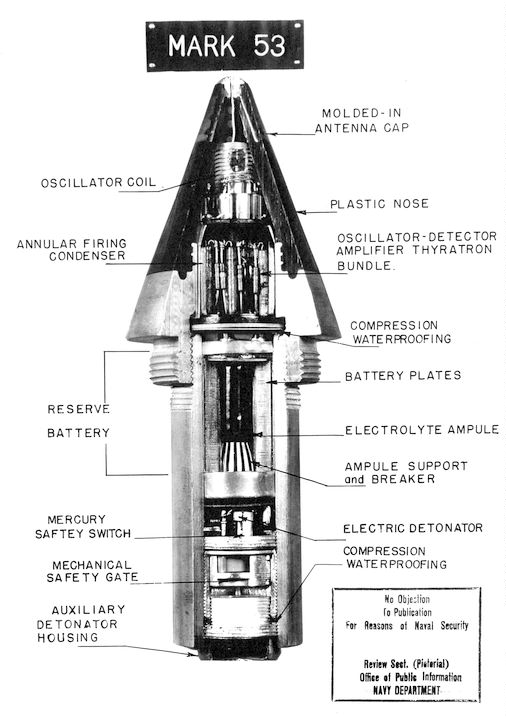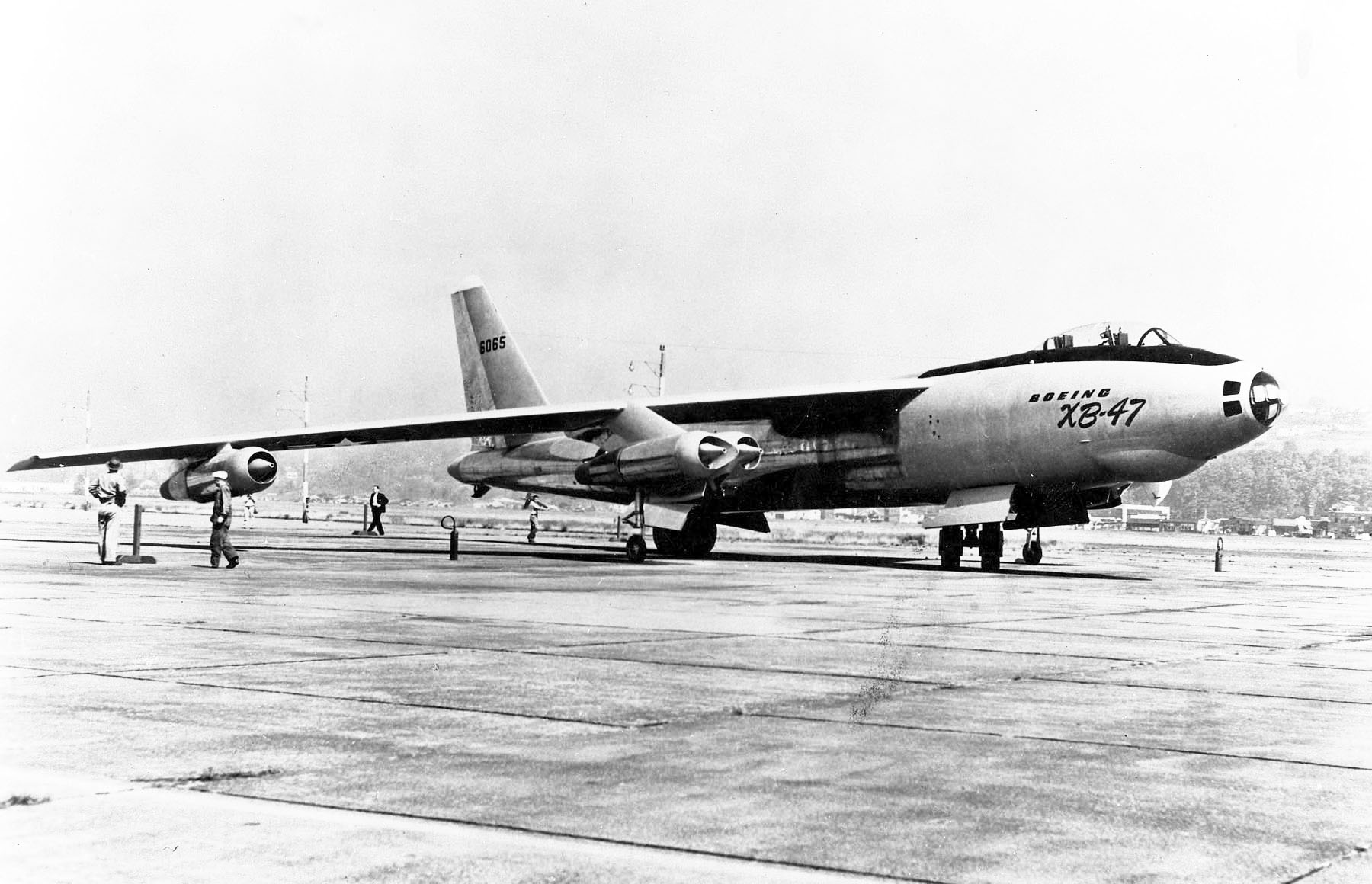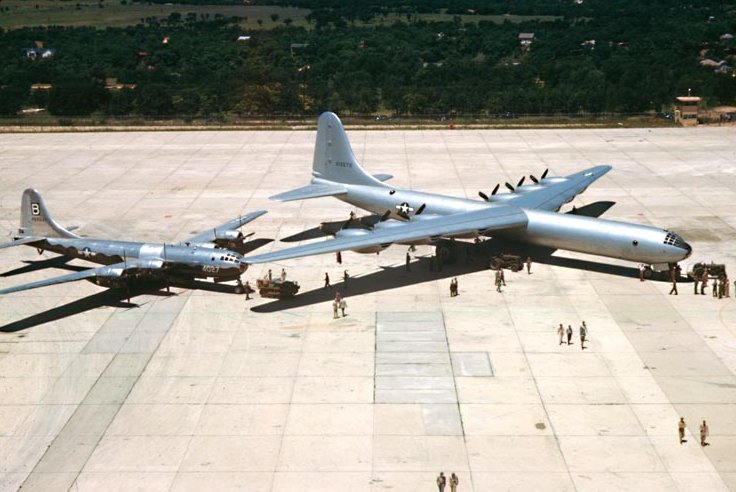|
Mark 21 Nuclear Bomb
The Mark 21 nuclear bomb was a United States thermonuclear gravity bomb first produced in 1955. It was based on the TX 21 "Shrimp" prototype that had been detonated during the Castle Bravo test in March 1954. While most of the Operation Castle tests were intended to evaluate weapons intended for immediate stockpile, or which were already available for use as part of the Emergency Capability Program, Castle Bravo was intended to test a design which would drastically reduce the size and costs of the first generation of air-droppable atomic weapons (the Mk 14, Mk 17 & Mk 24). Design At long, in diameter, a span over the fins, and weighing , the Mk 21 was half the length and less than half the weight of the Mk 17/24 weapons it replaced. The Mk 21 Y1 had a yield of 18 to 19 megatons. The "clean" Mk 21 Y2 (later designated Mk 26) was tested at 4.5 megatons. All 275 Mk 21 weapons stockpiled were the Y1 version. Quantity production of the Mk 21 started in December 1955 and ra ... [...More Info...] [...Related Items...] OR: [Wikipedia] [Google] [Baidu] |
Thermonuclear Weapon
A thermonuclear weapon, fusion weapon or hydrogen bomb (H bomb) is a second-generation nuclear weapon design. Its greater sophistication affords it vastly greater destructive power than first-generation nuclear bombs, a more compact size, a lower mass, or a combination of these benefits. Characteristics of nuclear fusion reactions make possible the use of non-fissile depleted uranium as the weapon's main fuel, thus allowing more efficient use of scarce fissile material such as uranium-235 () or plutonium-239 (). The first full-scale thermonuclear test was carried out by the United States in 1952; the concept has since been employed by most of the world's nuclear powers in the design of their weapons. Modern fusion weapons consist essentially of two main components: a nuclear fission primary stage (fueled by or ) and a separate nuclear fusion secondary stage containing thermonuclear fuel: the heavy hydrogen isotopes deuterium and tritium, or in modern weapons lithium deuteri ... [...More Info...] [...Related Items...] OR: [Wikipedia] [Google] [Baidu] |
Mark 36 Nuclear Bomb
The Mk 36 was a heavy high-yield nuclear bomb designed in the 1950s. It was a thermonuclear, using a multi-stage fusion secondary system to generate yields up to about 10 megatons TNT equivalent. History The Mark 36 was a more advanced version of the earlier Mark 21 nuclear bomb, which was a weaponized version of the "Shrimp" design, the first "dry" (lithium deuteride) fuel thermonuclear bomb the United States tested, in the Castle Bravo thermonuclear test in 1954. The Mark 21 bomb was developed and deployed immediately after Castle Bravo, in 1955. The Mark 21 design continued to be improved and the Mark 36 device started production in April 1956. In 1957, all older Mark 21 bombs were converted to Mark 36 Y1 Mod 1 bombs. A total of 920 Mark 36 bombs were produced as new build or converted from the 275 Mark 21 bombs produced earlier. All Mark 36 nuclear bombs were retired between August 1961 and January 1962, replaced by the higher yield B41 nuclear bomb Survivors A Mark 3 ... [...More Info...] [...Related Items...] OR: [Wikipedia] [Google] [Baidu] |
Cold War Aerial Bombs Of The United States
Cold is the presence of low temperature, especially in the atmosphere. In common usage, cold is often a subjective perception. A lower bound to temperature is absolute zero, defined as 0.00K on the Kelvin scale, an absolute thermodynamic temperature scale. This corresponds to on the Celsius scale, on the Fahrenheit scale, and on the Rankine scale. Since temperature relates to the thermal energy held by an object or a sample of matter, which is the kinetic energy of the random motion of the particle constituents of matter, an object will have less thermal energy when it is colder and more when it is hotter. If it were possible to cool a system to absolute zero, all motion of the particles in a sample of matter would cease and they would be at complete rest in the classical sense. The object could be described as having zero thermal energy. Microscopically in the description of quantum mechanics, however, matter still has zero-point energy even at absolute zero ... [...More Info...] [...Related Items...] OR: [Wikipedia] [Google] [Baidu] |
List Of Nuclear Weapons
This is a list of nuclear weapons listed according to country of origin, and then by type within the states. United States US nuclear weapons of all types – bombs, warheads, shells, and others – are numbered in the same sequence starting with the Mark 1 and () ending with the W-91 (which was canceled prior to introduction into service). All designs which were formally intended to be weapons at some point received a number designation. Pure test units which were experiments (and not intended to be weapons) are not numbered in this sequence. Early weapons were very large and could only be used as free fall bombs. These were known by "Mark" designators, like the Mark 4 which was a development of the Fat Man weapon. As weapons became more sophisticated they also became much smaller and lighter, allowing them to be used in many roles. At this time the weapons began to receive designations based on their role; bombs were given the prefix "B", while the same warhead used in other r ... [...More Info...] [...Related Items...] OR: [Wikipedia] [Google] [Baidu] |
United States Air Force
The United States Air Force (USAF) is the air service branch of the United States Armed Forces, and is one of the eight uniformed services of the United States. Originally created on 1 August 1907, as a part of the United States Army Signal Corps, the USAF was established as a separate branch of the United States Armed Forces in 1947 with the enactment of the National Security Act of 1947. It is the second youngest branch of the United States Armed Forces and the fourth in order of precedence. The United States Air Force articulates its core missions as air supremacy, global integrated intelligence, surveillance and reconnaissance, rapid global mobility, global strike, and command and control. The United States Air Force is a military service branch organized within the Department of the Air Force, one of the three military departments of the Department of Defense. The Air Force through the Department of the Air Force is headed by the civilian Secretary of the ... [...More Info...] [...Related Items...] OR: [Wikipedia] [Google] [Baidu] |
Air Burst
An air burst or airburst is the detonation of an explosive device such as an anti-personnel artillery shell or a nuclear weapon in the air instead of on contact with the ground or target. The principal military advantage of an air burst over a ground burst is that the energy from the explosion (as well as any shell fragments) is distributed more evenly over a wider area; however, the peak energy is lower at ground zero. History Air burst artillery has a long history. The shrapnel shell was invented by Henry Shrapnel of the British Army in about 1780 to increase the effectiveness of canister shot. It was widely used by the time of the War of 1812 and stayed in use until it was superseded during the First World War. Modern shells, though sometimes called "shrapnel shells", actually produce fragments and splinters, not shrapnel. Air bursts were used in the First World War to shower enemy positions and men with shrapnel balls to kill the largest possible number with a s ... [...More Info...] [...Related Items...] OR: [Wikipedia] [Google] [Baidu] |
Fuze
In military munitions, a fuze (sometimes fuse) is the part of the device that initiates function. In some applications, such as torpedoes, a fuze may be identified by function as the exploder. The relative complexity of even the earliest fuze designs can be seen in cutaway diagrams. A fuze is a device that detonates a munition's explosive material under specified conditions. In addition, a fuze will have safety and arming mechanisms that protect users from premature or accidental detonation. For example, an artillery fuze's battery is activated by the high acceleration of cannon launch, and the fuze must be spinning rapidly before it will function. "Complete bore safety" can be achieved with mechanical shutters that isolate the detonator from the main charge until the shell is fired. A fuze may contain only the electronic or mechanical elements necessary to signal or actuate the detonator, but some fuzes contain a small amount of primary explosive to initiate the detonation. ... [...More Info...] [...Related Items...] OR: [Wikipedia] [Google] [Baidu] |
Operation Redwing
Operation Redwing was a United States series of 17 nuclear test detonations from May to July 1956. They were conducted at Bikini and Enewetak atolls by Joint Task Force 7 (JTF7).Blumenson, Martin and Hugh D. Hexamer (1956). ''A History of Operation Redwing: The Atomic Weapons Tests in the Pacific''. Joint Task Force Seven Headquarters, Washington, D.C. p. 19. The entire operation followed '' Project 56'' and preceded '' Project 57''. The primary intention was to test new, second-generation thermonuclear weapons. Also tested were fission devices intended to be used as primaries for thermonuclear weapons, and small tactical weapons for air defense. ''Redwing'' demonstrated the first United States airdrop of a deliverable hydrogen bomb during test ''Cherokee''. Because the yields for many tests at Operation Castle in 1954 were dramatically higher than predictions, ''Redwing'' was conducted using an "energy budget": There were limits to the total amount of energy released, and t ... [...More Info...] [...Related Items...] OR: [Wikipedia] [Google] [Baidu] |
B-47
The Boeing B-47 Stratojet (Boeing company designation Model 450) is a retired American long- range, six-engined, turbojet-powered strategic bomber designed to fly at high subsonic speed and at high altitude to avoid enemy interceptor aircraft. The primary mission of the B-47 was as a nuclear bomber capable of striking targets within the Soviet Union. Development of the B-47 can be traced back to a requirement expressed by the United States Army Air Forces (USAAF) in 1943 for a reconnaissance bomber that harnessed newly developed jet propulsion. Another key innovation adopted during the development process was the swept wing, drawing upon captured German research. With its engines carried in nacelles underneath the wing, the B-47 represented a major innovation in post-World War II combat jet design, and contributed to the development of modern jet airliners. Suitably impressed, in April 1946, the USAAF ordered two prototypes, designated "XB-47"; on 17 December 1947, the first pr ... [...More Info...] [...Related Items...] OR: [Wikipedia] [Google] [Baidu] |
B-36
The Convair B-36 "Peacemaker" is a strategic bomber that was built by Convair and operated by the United States Air Force (USAF) from 1949 to 1959. The B-36 is the largest mass-produced piston-engined aircraft ever built. It had the longest wingspan of any combat aircraft ever built, at . The B-36 was the first bomber capable of delivering any of the nuclear weapons in the U.S. arsenal from inside its four bomb bays without aircraft modifications. With a range of and a maximum payload of , the B-36 was capable of intercontinental flight without refuelling. Entering service in 1948, the B-36 was the primary nuclear weapons delivery vehicle of Strategic Air Command (SAC) until it was replaced by the jet-powered Boeing B-52 Stratofortress beginning in 1955. All but four aircraft have been scrapped. Development The genesis of the B-36 can be traced to early 1941, prior to the entry of the United States into World War II. At the time, the threat existed that Britain might fall to t ... [...More Info...] [...Related Items...] OR: [Wikipedia] [Google] [Baidu] |
Mark 24 Nuclear Bomb
The Mark 24 nuclear bomb was an American thermonuclear bomb design, based on the third American thermonuclear bomb test, Castle Yankee. The Mark 24 bomb was tied as the largest weight and size nuclear bomb ever deployed by the United States, with the same size and weight as the Mark 17 nuclear bomb which used a very similar design concept but unenriched Lithium. The Castle Yankee thermonuclear test was the first bomb to use enriched Lithium-6 isotope, up to perhaps 40% enrichment (the earlier Castle Bravo test had used the same enriched lithium combination but was not weaponised i.e. was not built as a deployable bomb). The device tested was called the Runt II design; it was reportedly very similar to the Runt design tested in Castle Romeo, other than the enrichment level. Castle Yankee had a demonstrated yield of 13.5 megatons. The yield for the weaponized Mark 24 was predicted to be 10–15 megatons. The EC24 bomb was a limited production run of the Castle Yankee test device, ... [...More Info...] [...Related Items...] OR: [Wikipedia] [Google] [Baidu] |
Megatons
TNT equivalent is a convention for expressing energy, typically used to describe the energy released in an explosion. The is a unit of energy defined by that convention to be , which is the approximate energy released in the detonation of a metric ton (1,000 kilograms) of TNT. In other words, for each gram of TNT exploded, (or 4184 joules) of energy is released. This convention intends to compare the destructiveness of an event with that of conventional explosive materials, of which TNT is a typical example, although other conventional explosives such as dynamite contain more energy. Kiloton and megaton The "kiloton (of TNT)" is a unit of energy equal to 4.184 terajoules (). The "megaton (of TNT)" is a unit of energy equal to 4.184 petajoules (). The kiloton and megaton of TNT have traditionally been used to describe the energy output, and hence the destructive power, of a nuclear weapon. The TNT equivalent appears in various nuclear weapon control treaties, and has bee ... [...More Info...] [...Related Items...] OR: [Wikipedia] [Google] [Baidu] |






